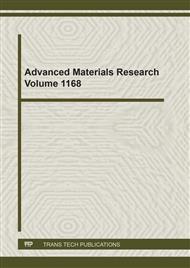[1]
G. Bidone, Observations on the Height of the Hydraulic Jump. A report presented in meeting of royal academy of science of turin. (1819) 21–80.
Google Scholar
[2]
J.B. Belanger, Essai sur la solution numérique de quelques problèmes relatifs au movement permanent des eaux courantes [Essay on the numerical solution of some problems related to the permanent movement of flowing water]. Carilian-Goeury, Paris (1828).
Google Scholar
[3]
B.A. Bakhmeteff, A.E. Matzake, The Hydraulic Jump terms of dynamic similarity, Transactions, American society of civil engineers. 101 (1936) 630–647.
DOI: 10.1061/taceat.0004708
Google Scholar
[4]
W.L. Moore, Energy loss at the base of a free overfall, Trans. ASCE. 108 (1943) 1343–1392.
Google Scholar
[5]
M. Debabeche, B. Achour, Effect of sill in the hydraulic jump in a triangular channel, Journal of Hydraulic Research. 45 (2007) 135–139.
DOI: 10.1080/00221686.2007.9521753
Google Scholar
[6]
R.J.G. Mohammad, A. Jalal, F.R. Samira, Study of flow and hydraulic jump along side weirs. Proceedings of the Institution of Civil Engineers, Water Management. 171 (2018) 134- 142.
DOI: 10.1680/jwama.14.00133
Google Scholar
[7]
C.J. Posey, P.S. Hsing, Hydraulic jump in trapezoidal channel, Engineering News-Record. 121 (1938) 797–798.
Google Scholar
[8]
I. Ohtsu, Free hydraulic jump and submerged hydraulic jump in trapezoidal and rectangular channels, Trans. JSCE. 8 (1976a) 122–125.
DOI: 10.2208/jscej1969.1976.246_57
Google Scholar
[9]
P. Silvester, Hydraulics Jump in all Shapes of Horizontal Channels, Proc. ASCE, Journal of Hydraulic Division. 90 (1964) 23–55.
DOI: 10.1061/jyceaj.0000977
Google Scholar
[10]
R. Wanoschek, W.H. Hager, Hydraulic jump in trapezoidal channel, Journal of Hydraulic Research. 27 (1989a) 429–446.
DOI: 10.1080/00221688909499175
Google Scholar
[11]
B. Afzal, A. Bushra, Structure of the turbulent hydraulic jump in trapezoidal Channel, Journal of Hydraulic Research. 40 (2002) 205–214.
DOI: 10.1080/00221680209499863
Google Scholar
[12]
S. Kateb, M. Debabeche, A. Benmalek, Etude expérimentale de l'effet de la marche positive sur le ressaut hydraulique évoluant dans un canal trapézoïdal [Experimental study of the effect of the positive step on a hydraulic jump in a trapezoidal channel], Canadian Journal of Civil Engineering. 40 (2013) 1014–1018.
DOI: 10.1139/cjce-2013-0359
Google Scholar
[13]
S. Cherhabil, M. Debabeche, Experimental Study of Sequent Depths Ratio of Hydraulic Jump in Sloped Trapezoidal Chanel, 6th International Symposium on Hydraulic Structures and Water System Management. ISBN 978-1-884575-75-4 (2016).
DOI: 10.1063/1.4976222
Google Scholar
[14]
S. Kateb, M. Debabeche, F. Riguet, Hydraulic jump in a sloped trapezoidal channel, International Conference on Technologies and Materials for Renewable Energy, Environment and Sustainability, TMREES15, Energy Procedia. 74 (2015) 251–257.
DOI: 10.1016/j.egypro.2015.07.591
Google Scholar
[15]
A. Abbaspour, T. Taghavianpour, H. Arvanaghi, Experimental study of the hydraulic jump on reverse bed with porous screens, Applied Water Science 155 (9) (2019).
DOI: 10.1007/s13201-019-1032-7
Google Scholar
[16]
S. Ebrahimiyan, H. Hajikandi, M. Shafai Bejestan, S. Jamali, E. Asadi, Experimental study on the effect of sediment concentration on trapezoidal hydraulic jump, Proceedings of the Institution of Civil Engineers - Water Management 173 (2020) 317-324.
DOI: 10.1680/jwama.19.00081
Google Scholar
[17]
K.M. Zounemat, M.M.A. Amin, Embedded Fuzzy-Based Models in hydraulic jump prediction, Journal of Hydroinformatics. 23 (2021) 151-170.
DOI: 10.2166/hydro.2020.347
Google Scholar
[18]
G.Y. Luo, H. Cao, H. Pan, Method to locate the toe of a hydraulic jump on sloping channels. KSCE Journal of Civil Engineering. 25 (2021) 124-139.
DOI: 10.1007/s12205-020-0081-7
Google Scholar
[19]
J. Vimaldoss, B. Ram, B. Tirupati, Numerical study of a symmetric submerged spatial hydraulic jump, Journal of Hydraulic Research. 58 (2020) 335-349.
DOI: 10.1080/00221686.2019.1581668
Google Scholar
[20]
R. Dimitrios, K. Giorgos, W. Ko van der, Continuous hydraulic jumps in laminar channel flow, Journal of Fluid Mechanics. 915 (2021) A8.
DOI: 10.1017/jfm.2021.31
Google Scholar
[21]
M. Debabeche, Ressaut hydraulique dans les canaux prismatiques [Hydraulic jump in prismatic canals], PhD thesis, Department of Hydraulics, University of Biskra, Algeria (2003).
Google Scholar


